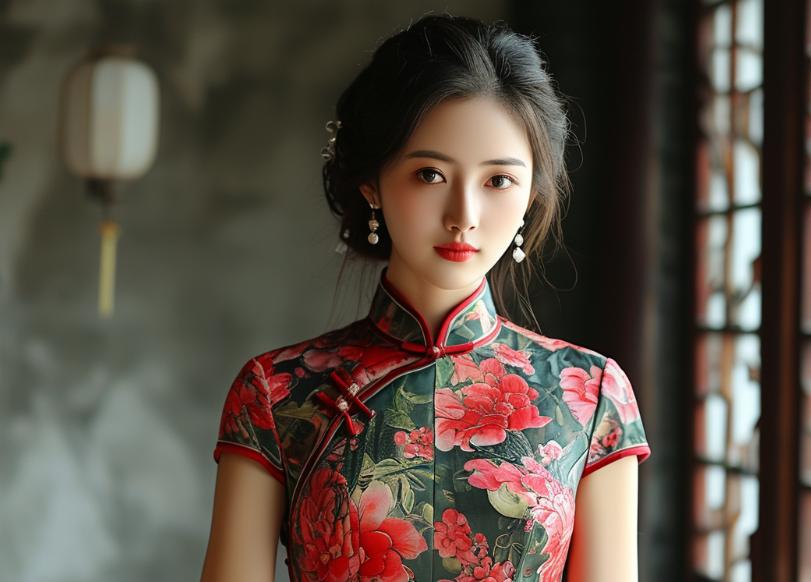
Qipao, also known as cheongsam, is a traditional Chinese dress. The style of the qipao has changed over the decades and it is still worn today.
The history of the qipao can be dated back to the Qing Dynasty, when the Manchu ethnic group people were called Qi people by Han Chinese. So, the women's changpao was called a qipao by the Han Chinese. The original qipao worn during the Manchu rule was wide and baggy. The Chinese dress featured a high neck and straight skirt. It covered all of a woman’s body except for her head, hands, and toes. The qipao was traditionally made of silk and featured intricate embroidery (复杂的刺绣).
In the 1920s in Shanghai, the qipao was modernized and became popular among celebrities and the upper class. It changed into a one-piece, form-fitting dress that has a high slit (开叉) on one or both sides. It became one of the official national dresses of the Republic of China in 1929. The qipaos worn today are modeled after the ones made in Shanghai in the 1920s. Modern qipaos may have bell sleeves or be sleeveless and are made out of a variety of different materials.
In the 17th century, women wore qipao nearly every day. During the 1920s in Shanghai, 1950s in Hong Kong, the qipao was also worn casually quite often. Nowadays, women do not wear a qipao as everyday clothes. Qipaos are now worn only during formal occasions like weddings, parties, and beauty contests. The qipao is also used as a uniform at restaurants and hotels and on airplanes in Asia.
原创编写 版权所有 侵权必究! 每日更新 个性化阅读 英语飙升!
1.1.The qipao first appeared in __________
A the Qing Dynasty
B the Ming Dynasty
C the Tang Dynasty
D the Song Dynasty
解析:选A。细节理解题。根据第二段的“The history of the qipao can be dated back to the Qing Dynasty”可知,旗袍的历史可以追溯到清朝,即在清朝时期开始出现。故选A。
2.2.What was the original qipao like?
A It was very short.
B It was big and wide.
C It was easily made.
D It was made of cotton.
解析:选B。细节理解题。根据第二段的“The original qipao worn during the Manchu rule was wide and baggy. The Chinese dress featured a high neck and straight skirt. It covered all of a woman’s body except for her head, hands, and toes.”最初的旗袍宽大宽松,特点是高领直裙。它覆盖了除了头、手和脚趾以外的整个女人的身体。故选B。
3.3.What can we know about qipaos worn today?
A They are usually made of silk with no sleeves.
B They are popular among celebrities in Shanghai.
C They copy the original qipaos from the Qing Dynasty.
D They look like the ones made in Shanghai in the 1920s.
解析:选D。细节理解题。根据第三段的“The qipaos worn today are modeled after ones made in Shanghai in the 1920s. Modern qipaos may have bell sleeves or be sleeveless and are made out of a variety of different materials.”可知,现在人们穿的旗袍是模仿20世纪20年代上海制造的旗袍。现代旗袍可能有喇叭袖或无袖,由各种不同的材料制成。故选D。
4.4.Which of the following can be a subtitle (副标题) for the last paragraph?
A When a Qipao Is Worn.
B What a Qipao Looks Like.
C Where You Can Buy a Qipao.
D Why a Qipao Is Worn Daily.
解析:选A。段落大意题。根据最后一段大意“在17世纪,妇女几乎每天都穿旗袍。在20世纪20年代的上海和50年代的香港,旗袍也经常被随意穿著。现在,妇女不穿旗袍作为日常服装。旗袍现在只在婚礼、聚会和选美比赛等正式场合穿。在亚洲,旗袍也被用作餐厅、酒店和飞机上的制服。”可知,本段主要描述的是“何时穿旗袍”。故选A。
5.5.Where can readers most probably read the passage?
A In a travel guidebook.
B On an art website.
C In a fashion magazine.
D In a geography textbook.
解析:选C。推理判断题。根据全文内容可知,本文主要介绍了中国传统服饰旗袍的相关内容,结合选项可知,最有可能出现在一本(服装相关的)时尚杂志上。故选C。